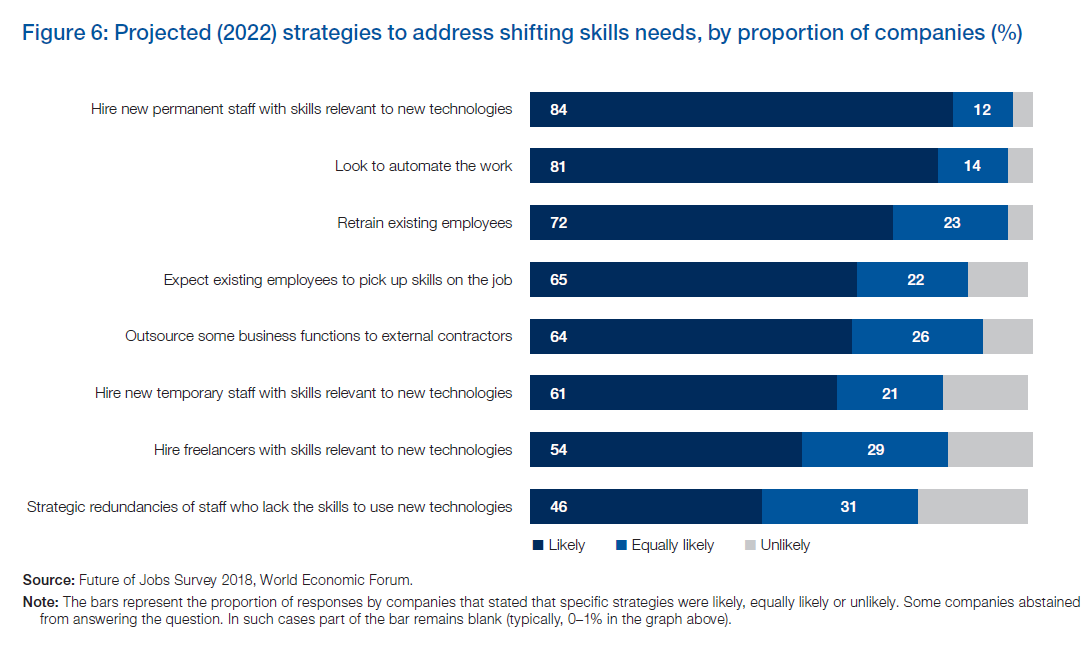The World Economic Forum released their 2018 Future of Jobs report. It is a survey of business executives representing many of the multinational companies around the world to get a pulse on their workforce strategies for the upcoming period 2018 to 2022. An overarching theme of the report is how technology – particularly ubiquitous high-speed internet, AI, adoption of big data analytics, and cloud technology – is pervasive and impacting every facet of a company’s workforce strategy; according to the report, there are “complex feedback loops between new technology, jobs, and skills”. Some of the key points from the report are:
- Companies are forced to consider adopting new technology to remain competitive. Their most decisive metric is productivity.
- Companies ‘geography of production, distribution and value chains’ are changing. Seventy-four percent of respondents prioritize ‘the availability of skilled local talent’ as their biggest concern.
- Changing employment types. Automation is creating an ominous cloud of uncertainty: how is automation going to impact workers.
- Growing skills instability. The average skills stability is fifty-eight percent from the 2018 to 2022 period. This means the shelf life of forty-two percent of required skills expires in less than five years. The top in-demand skills of 2022 are foundational thinking and soft skills.
- Reskilling is imperative. By 2022, fifty-four percent of all employees will require significant re- and upskilling.
There is significant commentary about how fundamental changes in technology is impacting the skills of the current and future workforce. Companies will have to decide whether to ‘prioritize automation’ or ‘augmentation’ and whether to ‘invest in workforce reskilling’.
As noted in the survey, the survey is directed at large multinational employers so does not necessarily capture the perspectives of small and medium sized companies. Furthermore, it does not consider ‘employment sectors’. With a smaller company in IT or health care, (I assume) there is greater demand on the adaptability of workers to learn new skills.
I recommend a suite of applications based on skills – Skills Culture, Skills Based Approach, and Skills Label – as part of the solution for your organization:
Skills Based Approach is a methodology centered on the development of an evolving skill set by constantly cycling through four stages: planning, building, presenting, and validating. It has both micro and macro benefits, meaning it is useful to both individuals and organizations and communities. Applying the methodology is an ideal way to address ‘growing skills instability’, ‘reskilling imperative’, and the ‘skills gap’ because of its flexibility and adaptiveness to the changing demands in skills. Companies signal their current and future demands for skills; individuals target the skills and cycle through the four stages to acquire them.
Skills Label is a system to track the development of skills. This is precisely what is needed to prepare new hires and structure the learning in re- and upskilling programs. There is a direct one to one translation between the learning expectations (in skills and their underlying methods and applications) and the demand for those skills; this communication can occur between education institutions and the companies themselves. According to the survey: “Tangible collaboration opportunities include partnering with educators to reshape school and college curricula, intra- and inter-industry collaboration on building talent pipelines, and partnerships with labour unions to enhance cross-industry talent mobility.”
With Skills Culture, I have talked in-depth about having an Agile Worker – someone who is willing to step in and learn skills as they are needed. This was a conclusion made in the survey: “the success of any workforce augmentation strategy is the buy-in of a motivated and agile workforce, equipped with futureproof skills to take advantage of new opportunities through continuous retraining and upskilling”. Skill Culture is the growth mindset to accomplish these requirements.
